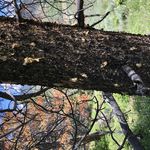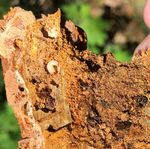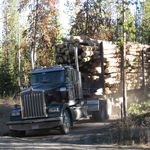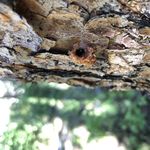Wilder-Highlands Mountain Pine Beetle Response Project Frequently Asked Questions - National Forest Foundation
←
→
Page content transcription
If your browser does not render page correctly, please read the page content below
Wilder-Highlands Mountain Pine Beetle Response Project Frequently Asked Questions About Mountain Pine Beetles (MPB) What is a mountain pine beetle? The mountain pine beetle (MPB) is a small native insect that lives most of its life in the inner bark of pine trees. These beetles are tree killers. What does MPB look like? Adult MPB are black to rusty brown and about ¼ of an inch in length. Their larvae are white and approximately the size of a grain of rice. How many MPB does it take to kill the tree? The exact number is not known – between tens and hundreds. If MPB enter a tree on all sides, a smaller number can take out the tree. When a MBP has entered a tree, the resin or “pitch” in the tree secretes out around the beetle and forms somewhat of a tube that looks like a piece of gum. The pitch tube is usually red in color due to the boring dust from tunneling into the bark of the tree. What trees do MPB attack? Normally trees that are weakened or stressed are susceptible to being attacked. In areas that are heavily infested, all trees are susceptible. MPB will usually attack the trees greater than eight inches in diameter. They will attack trees down to 4 inches in diameter when the MPB population is high. When do MPB fly? In late June through September, sometimes later if it’s been a good snow year. After the larvae have matured into beetles, they will be ready to leave the tree. The beetles usually leave the tree in large numbers at the beginning of August and flights will taper off by end of September. It takes MPB one year to develop from an egg to an adult. How far will MPB fly? Given that MPB is not a great flyer, they typically fly less than 300 feet but up to ½ mile. Wilder-Highlands Mountain Pine Beetle Response Project FAQ - March 19, 2020 Page 1
If MPB infest wood but it’s still green, is it safe to move the wood to another location? It is never a good idea to move firewood or logs a long distance from where you gather them. MPB larvae can survive and mature in green infested wood that is not properly treated and emerge to infest nearby healthy pine trees. Moving firewood to an area without pines (i.e., sagebrush) is a best practice. Does the MPB affect wildfire behavior? Yes. Although scientific literature shows no relationship between beetle-killed mortality and fire occurrence, wildfire behavior is dramatically affected by an altered arrangement of fuels in stands affected by MPB. Bark beetles reduce stand diameters by killing the largest trees first, which results in a release of ladder fuel growth in the forest understory. As heavy woody debris from fallen beetle-killed trees starts to accumulate, total flame length increases as the fuel arrangement is altered. Although higher wind speeds are needed to carry an active crown fire in stands impacted by MPB, the increase in total flame length may result in increased fire intensity. MPB and Forest Management How can forest management influence the mountain pine beetle? Forest management can be utilized to change the stand dynamic by removing susceptible trees and promoting regeneration, therefore protecting the remaining trees and leaving a more resilient forest. Additionally, thinning changes climatic conditions within a stand, reducing the effectiveness of MPB coordination through pheromones and increasing the vigor of the remaining trees. What are the options for managing MPB? There are two basic options: prevention or suppression, focused on individual trees or an entire landscape. Prevention involves creating stands more resilient to the beetles through thinning, density reduction, and diameter reduction, or by applying pesticides to individual trees. Suppression involves killing the beetles through sanitation of green infested trees going to the mill via timber sale, or individual tree suppression such as cutting and stripping bark, burning infested logs, or mastication. How do forest management activities change the forest? It may help to answer this question by thinking about what infested stands will look like without management. In the absence of forest management, vulnerable mature pines will likely be targeted, resulting in mortality. Over time, beetle-killed snags will fall as the root structure deteriorates, and “jack-straw” coarse woody material accumulates on the forest floor. Another forest disturbance, wildfire, is often the driving force that consumes the accumulation of coarse woody debris and promotes regeneration of the stand. While forest management does have a visual impact immediately following implementation, it promotes healthy regeneration in a controlled fashion. Depending on site conditions, forest management can stimulate a vigorous response of quaking aspen, promote the next generation of lodgepole pine, or stimulate regeneration of Douglas-fir. The healthy stands tended by forest management will be resilient for generations. Wilder-Highlands Mountain Pine Beetle Response Project FAQ - March 19, 2020 Page 2
MPB and Forest Management A forest MPB-affected stand with no forest A forest MPB-affected stand during forest management action taken. management action. Using prescribed fire to manage slash piles on A MPB-affected stand one year after forest a forestry project in the aspen, Douglas-fir and management actions. lodgepole pine forest type. Remnant large diameter Douglas-fir with Healthy and resilient natural regeneration of vigorous aspen suckering three years after forest lodgepole pine six years after forest management management actions. actions in a MPB-affected stand. Wilder-Highlands Mountain Pine Beetle Response Project FAQ - March 19, 2020 Page 3
The Proposed Wilder-Highlands MPB Response Project Why is this project a priority? We have identified a MPB outbreak across 580 acres of lodgepole pine stands in Taylor Canyon on National Forest System lands and private lands (Wilder on the Taylor and Gunnison Highlands communities). MPB outbreaks can lead to catastrophic landscape-scale disturbances. The proposed Wilder-Highlands Project would attempt to mitigate the current outbreak and prevent a landscape-scale disturbance. Where are the beetles likely to spread across the landscape? MPB will spread to any susceptible host trees. At lower elevations, once they leave the tree, they typically find the closest host available. We cannot predict which way they will spread. They can be wind aided generally ¼ to ½ mile, depending on topography, which is why ridgetops are frequently hit first. As populations increase, MPB tend to travel a longer range (½ mile give or take) largely because there are so many more beetles looking for suitable hosts. Pine stands to the northeast, east, southeast, and south of the currently infested stands are contiguous enough that beetles could fly to the tree next door or up to ½ mile away. Why are you proposing treatment on uninfested stands? The current beetle outbreak is developing quickly and we need to be adaptable to the changing conditions. This project has identified stands which could reasonably be impacted by the growing MPB population. Why are treatments proposed to the south, so far from uninfested stands? The lodgepole pine cover type south along the ridge in Gunnison Highlands is contiguous enough that MPB could fly tree-to-tree or stand-to-stand regardless of wind presence to aid or hinder movement. The lodgepole pine stand at the south to southeast end of the private land is dense, over mature, and continuous, making that area vulnerable to MPB attack and population expansion. Additionally, we recently identified new beetle infestations located south of those originally identified in 2019. How might my private property be affected? As we work to address the impact of MPB on the landscape, we understand that the forest on your property is changing as a result of this disturbance. We hope to educate private landowners about the impacts of MPB and provide consultation to landowners who wish to actively manage their property. Landowners can schedule an on-site assessment with a Colorado State Forest Service forester for site-specific information as well as management recommendations. Funding is available for landowners wishing to manage MPB through forest management. Should I use an insecticidal spray? Insecticidal spray can be used as a preventative to protect individual trees if applied before the tree is attacked by MPB. Spraying protects the tree by killing the beetles before they infest the tree. Insecticides containing the active ingredients permethrin or carbaryl (specifically labeled for bark beetle control) should be applied by early June to protect trees from MPB. Treatments need to be Wilder-Highlands Mountain Pine Beetle Response Project FAQ - March 19, 2020 Page 4
done by a certified professional on a yearly basis to individual trees and are not appropriate for
large acreages. Once a tree has been attacked, it is too late.
What is the overall timeframe for the project?
This project is expected to be implemented over approximately five years. Continual monitoring
of bark beetle populations, particularly if they continue to infect new stands, may dictate the
desire for additional work down the road.
What is the timeframe for the project in 2020?
The USFS expects to sign a decision for the components of this project on federal
lands in April 2020. On-the-ground planning of treatments would start late April with
initial treatments being implemented between late May and December 2020. Private
landowners can engage in the project at their discretion. Colorado State Forest
Service foresters are available to provide an on-site assessment for landowners who
are interested in participating in forest management activities.
With the limited amount of time to implement prior to beetle flight this year, why the rush?
Any action is better than no action. We want to remove any trees that are currently infested with
MPB larvae as these beetles will only fuel the epidemic. Removing as many infested trees
as possible before the beetles leave the tree will cut down the resident beetle population
and reduce spread and tree mortality in the short term.
Which treatment areas are prioritized and how are you proposing to access these
treatment areas?
Prioritization is multi-faceted. Current bark beetle infested stands will be prioritized
based on current and projected population growth utilizing ground-truthing, aerial
survey and monitoring. On-going monitoring and assessment will allow us to refine the
treatment areas in a dynamic nature throughout the life of the project.
Priorities may shift. We have identified all available stands of lodgepole pine as potential
treatment areas, as they have the potential to foster MPB broods or are currently infested, so we
wanted to keep them available for treatment. Other factors that may influence prioritization of
treatment areas include access, as well as landowner engagement and willingness to participate.
How is this project being funded?
The USFS is currently providing the majority of initial funding through an agreement with the
National Forest Foundation (NFF), which would allow us to implement the first phase of the
project. The NFF will be working in coordination with Colorado State Forest Service to seek
additional funding to allow for full project implementation.
We will be identifying and pursuing grants and donations from foundations, public agencies,
private entities and individuals who may be interested in supporting the project in the future.
For more information about the proposed Wilder-Highlands
MPB Response Project, please visit the USFS project website:
www.fs.usda.gov/project/?project=57554
Wilder-Highlands Mountain Pine Beetle Response Project FAQ - March 19, 2020 Page 5You can also read



























































